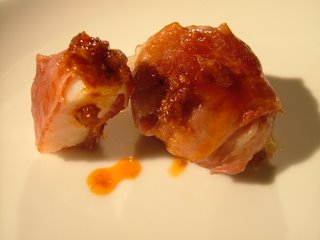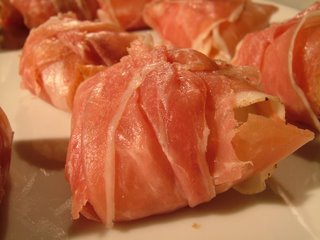The samphire season has just begun, and with this in mind, we drove up to Norfolk at the weekend with a coolbag to try to find some at a fishmonger. Unfortunately, it being a Bank Holiday, everybody else and his mother had also driven up to Norfolk. The fishmongers were empty of anything you’d have fancied eating, as if picked over by piscine locusts, and every seaside town we encountered was so full of people that we gave up and decided to go for a hike into the bleak salt marshes near Stiffkey (pronounced ‘Stooky’) to get away from everybody. Picnic backpack hoisted aloft, legs encased in waterproof boots, we walked out about three miles until we found the perfect spot by one of the causeway bridges that punctuate the saltmarshes – flowing, salty water running through a sticky clay bed. This is perfect samphire territory, and sure enough, there were beds and beds of the stuff growing along the water margin. I scrambled down into the water, offering up a prayer to the makers of Gore-Tex, and picked enough, roots and all, to fill both our picnic napkins.
Samphire is a glasswort, sometimes called sea-asparagus. (See the picture below for a bowl of raw, cleaned samphire.) There are a few different plants which are called samphire – we’re after the best-tasting variety, marsh samphire, which is a spectacular bright green, and grows in salty mud. The samphire Shakespeare mentions in King Lear was probably rock samphire, which is comparatively bitter. Marsh samphire has an assertively salty flavour reminiscent of oysters, and is tender enough to be eaten raw in a salad. (Dr W and I found ourselves snacking on it raw as I picked, straight out of the mud.) At this time of year, the samphire is young and tender – aim to collect shoots about the length of your forefinger, roots and all. Wrap them in a damp cloth and they’ll keep nicely in the fridge for a few days. To prepare, just rinse carefully in cold water from the tap and snip the roots off with scissors. Older samphire may be a bit twiggy – use your judgement, and snip off anything that’s not a tender tip.
If foraging’s not your thing, Tig (who is extraordinarily good value on the subject of seaweed and other salty things) mentioned in the comments of an earlier sea-vegetable post that the Fish Society will send mail-order samphire to you, in season.
Samphire’s at its absolute best with shellfish, so I grabbed a bag of tiny, sweet queen scallops from the supermarket and came up with this dish, which makes the most of the odd affinity pork has with scallops and samphire, sets them on delicious crisp discs, and marries the lot up with a beurre blanc flavoured with dill and Pernod. This looks and tastes most impressive, and while it’s a bit of a faff to put together, it’ll go down a storm at a dinner party, or served to people you love for a special occasion. To serve four as a starter or two as a main course, you’ll need:
150g cleaned marsh samphire
200g queen scallops
4 slices white multigrain bread
150g slim black pudding (if you can only find the pre-sliced kind, buy 12 slices)
3 fat, juicy cloves garlic
100g salted butter, plus another 225g salted butter for the beurre blanc
1 shallot
1 bay leaf
3 peppercorns
3 tablespoons white wine
2 tablespoons Pernod
1 tablespoon white wine vinegar
1 teaspoon double cream
2 tablespoons freshly chopped dill
Preheat the oven to 220°C while you chop the garlic finely, and cook it in 100g of butter until it is a very pale gold. Remove the garlic from the heat. Remove the crusts from the bread and use a rolling pin to roll the slices of bread until they are squashed flat, then use a round cookie cutter to make three circles out of each slice. Dip the twelve rounds in the garlic butter, lay on a baking sheet and cook on the top shelf of the oven for 8 minutes, until golden brown. Put on racks to cool.
Cut the black pudding into 12 rounds, leaving the skin on for now. Fry it over a medium heat in the remaining garlic butter for about 5 minutes per side, until the outsides are crisp. Peel off the skin and keep the little rounds of sausage on a plate in a warm place while you prepare the rest of the ingredients.
To make the beurre blanc, put the wine, Pernod and vinegar in a heavy-bottomed saucepan with the sliced shallot, the bay leaf and the peppercorns. Bring to a simmer and reduce until there are only two tablespoons of liquid left. Sieve the liquid to remove the shallot, bay and peppercorns, and return to the pan off the heat. Get the butter out of the fridge and cut it into cubes about the size of the top joint of your thumb.
Put the pan back over a low flame. Add a teaspoon of cream to the wine reduction and use a whisk to incorporate it into the liquid. (As I’ve mentioned in previous beurre blanc recipes, this addition of cream is cheating, but it does mean that your sauce won’t split.) Whisking vigorously, add the butter to the pan, three cubes at a time. When they are half-melted, add another three, still whisking hard. Repeat until all the butter is incorporated and remove from the heat.
When the beurre blanc is nearly ready, bring the remaining garlic butter and fat from the black pudding to a frying temperature and fry off the scallops for two minutes, until they are coloured and just barely cooked. Steam the samphire for four minutes.
To assemble the dish, make a little bed of steamed samphire on each plate, and put three discs of bread crisp on top. Put a slice of black pudding on each of these, pile the tiny scallops into the middle of the plate, and spoon over a generous amount of the beurre blanc. Serve immediately.



